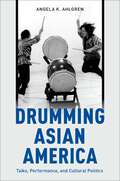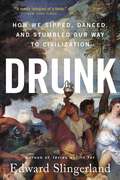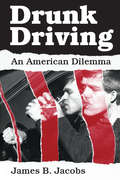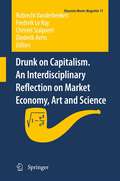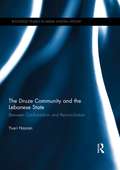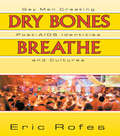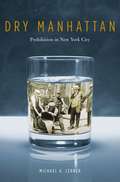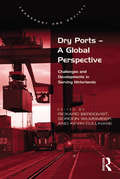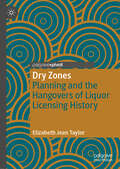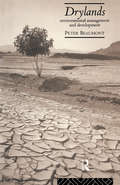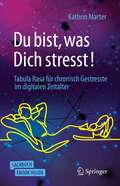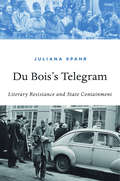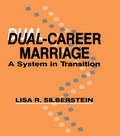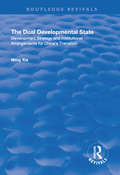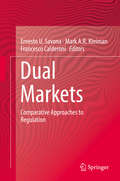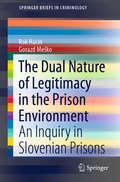- Table View
- List View
DRUMMING ASIAN AMERICA C: Taiko, Performance, and Cultural Politics
by Angela K. AhlgrenWith its dynamic choreographies and booming drumbeats, taiko has gained worldwide popularity since its emergence in 1950s Japan. Harnessed by Japanese Americans in the late 1960s, taiko's sonic largesse and buoyant energy challenged stereotypical images of Asians in America as either model minorities or sinister foreigners. While the majority of North American taiko players are Asian American, over 400 groups now exist across the US and Canada, and players come from a range of backgrounds. Using ethnographic and historical approaches, combined with in-depth performance description and analysis, this book explores the connections between taiko and Asian American cultural politics. Based on original and archival interviews, as well as the author's extensive experience as a taiko player, this book highlights the Midwest as a site for Asian American cultural production and makes embodied experience central to inquiries about identity, including race, gender, and sexuality. The book builds on insights from the fields of dance studies, ethnomusicology, performance studies, queer and feminist theory, and Asian American studies to argue that taiko players from a variety of identity positions perform Asian America on stage, as well as in rehearsals, festivals, schools, and through interactions with audiences. While many taiko players play simply for the love of its dynamism and physicality, this book demonstrates that politics are built into even the most mundane aspects of rehearsing and performing.
Drunk: How We Sipped, Danced, and Stumbled Our Way to Civilization
by Edward SlingerlandA "entertaining and enlightening" deep dive into the alcohol-soaked origins of civilization—and the evolutionary roots of humanity&’s appetite for intoxication. (Daniel E. Lieberman, author of Exercised) While plenty of entertaining books have been written about the history of alcohol and other intoxicants, none have offered a comprehensive, convincing answer to the basic question of why humans want to get high in the first place. Drunk elegantly cuts through the tangle of urban legends and anecdotal impressions that surround our notions of intoxication to provide the first rigorous, scientifically-grounded explanation for our love of alcohol. Drawing on evidence from archaeology, history, cognitive neuroscience, psychopharmacology, social psychology, literature, and genetics, Slingerland shows that our taste for chemical intoxicants is not an evolutionary mistake, as we are so often told. In fact, intoxication helps solve a number of distinctively human challenges: enhancing creativity, alleviating stress, building trust, and pulling off the miracle of getting fiercely tribal primates to cooperate with strangers. Our desire to get drunk, along with the individual and social benefits provided by drunkenness, played a crucial role in sparking the rise of the first large-scale societies. We would not have civilization without intoxication. From marauding Vikings and bacchanalian orgies to sex-starved fruit flies, blind cave fish, and problem-solving crows, Drunk is packed with fascinating case studies and engaging science, as well as practical takeaways for individuals and communities. The result is a captivating and long overdue investigation into humanity's oldest indulgence—one that explains not only why we want to get drunk, but also how it might actually be good for us to tie one on now and then.
Drunk Driving: An American Dilemma (Studies in Crime and Justice)
by James B. JacobsIn this ambitious interdisciplinary study, James B. Jacobs provides the first comprehensive review and analysis of America's drunk driving problem and of America's anti-drunk driving policies and jurisprudence. In a clear and accessible style, he considers what has been learned, what is being done, and what constitutional limits exist to the control and enforcement of drunk driving.
Drunk Driving: An American Dilemma (Studies in Crime and Justice)
by James B. JacobsIn this ambitious interdisciplinary study, James B. Jacobs provides the first comprehensive review and analysis of America's drunk driving problem and of America's anti-drunk driving policies and jurisprudence. In a clear and accessible style, he considers what has been learned, what is being done, and what constitutional limits exist to the control and enforcement of drunk driving.
Drunk Driving: An American Dilemma (Studies in Crime and Justice)
by James B. JacobsIn this ambitious interdisciplinary study, James B. Jacobs provides the first comprehensive review and analysis of America's drunk driving problem and of America's anti-drunk driving policies and jurisprudence. In a clear and accessible style, he considers what has been learned, what is being done, and what constitutional limits exist to the control and enforcement of drunk driving.
Drunk Driving: An American Dilemma (Studies in Crime and Justice)
by James B. JacobsIn this ambitious interdisciplinary study, James B. Jacobs provides the first comprehensive review and analysis of America's drunk driving problem and of America's anti-drunk driving policies and jurisprudence. In a clear and accessible style, he considers what has been learned, what is being done, and what constitutional limits exist to the control and enforcement of drunk driving.
Drunk on Capitalism. An Interdisciplinary Reflection on Market Economy, Art and Science (Einstein Meets Magritte: An Interdisciplinary Reflection on Science, Nature, Art, Human Action and Society #11)
by Robrecht Vanderbeeken, Frederik Le Roy, Christel Stalpaert and Diederik AertsThe book presents an interdisciplinary collection of analyses that discuss the impact of market economy on our culture in the post-Berlin Wall era. It contains two parts. The first focuses on the commercialisation of science and education. The second elaborates on the multiple and diverse relation between art and capital.
The Druze Community and the Lebanese State: Between Confrontation and Reconciliation (Routledge Studies in Middle Eastern History)
by Yusri HazranOne of the fundamental questions of Middle Eastern, and Lebanese studies in particular, is the history of the relationship between the Druze community and the state in modern Lebanon. Arguing that the Druze community has been politically alienated from the Lebanese state, this book explores the historical and political origins of this alienation. The Druze Community and the Lebanese State contends that the origins of this alienation lie in the state’s national ideology, its political confessional system, and the Druze’s historical background during the medieval period. Moreover, this book examines the extent to which the Druze’s attitude vis-à-vis the Lebanese state has been influenced by their historical rivalry with the Maronites. Particular emphasis is placed on the political and ideological practices adopted by the Druze leadership and intelligentsia as they dealt with the changes taking place in their community’s political status following the political settlements of 1920 and 1943 (the establishment of Greater Lebanon and the National Pact, respectively). A welcome addition to existing literature on Lebanon, this book will be an essential reference tool for students and researchers with an interest in nationalism, identity and Middle East Politics more broadly.
The Druze Community and the Lebanese State: Between Confrontation and Reconciliation (Routledge Studies in Middle Eastern History)
by Yusri HazranOne of the fundamental questions of Middle Eastern, and Lebanese studies in particular, is the history of the relationship between the Druze community and the state in modern Lebanon. Arguing that the Druze community has been politically alienated from the Lebanese state, this book explores the historical and political origins of this alienation. The Druze Community and the Lebanese State contends that the origins of this alienation lie in the state’s national ideology, its political confessional system, and the Druze’s historical background during the medieval period. Moreover, this book examines the extent to which the Druze’s attitude vis-à-vis the Lebanese state has been influenced by their historical rivalry with the Maronites. Particular emphasis is placed on the political and ideological practices adopted by the Druze leadership and intelligentsia as they dealt with the changes taking place in their community’s political status following the political settlements of 1920 and 1943 (the establishment of Greater Lebanon and the National Pact, respectively). A welcome addition to existing literature on Lebanon, this book will be an essential reference tool for students and researchers with an interest in nationalism, identity and Middle East Politics more broadly.
Dry Bones Breathe: Gay Men Creating Post-AIDS Identities and Cultures
by Eric RofesDry Bones Breathe: Gay Men Creating Post-AIDS Identities and Cultures breaks new ground in offering an original and insightful interpretation of gay men’s shifting experience of the AIDS epidemic. From Dry Bones Breathe, you’ll gain a deeper understanding of current community debates focused on circuit parties, unprotected sex, and gay men’s sexual cultures, and you will learn how social, political, and biomedical changes are dramatically transforming gay identities and cultures.Dry Bones Breathe is Eric Rofes’explosive follow-up to Reviving the Tribe, a book which broke open debates in gay communities around the world about sex, identity, and gay men’s relationship to AIDS. In this volume, Rofes contends that most gay men no longer experience AIDS as the crisis they did during the 1980s. Gay men often attribute this shift to the advent of protozoa inhibitors, but Rofes explains how other factors, including the epidemic’s predicted trajectory, new treatments for opportunistic infections, the passage of time, and the increasing diversity of gay men inhabiting communities throughout the country have set in motion the transformation of gay life. AIDS organizations and gay leaders, however, continue to assert that gay men experience AIDS as an emergency, resulting in a tremendous dissonance between gay leaders and their communities. In the midst of this controversy, Dry Bones Breathe lets you share in stories of hope and recovery and a new vision for AIDS work that demands a radical redesign of prevention, care, and activism. Dry Bones Breathe tackles several other issues concerning the powerful shifts occurring in gay communities and cultures by: explaining why an understanding of the terms “post-AIDS” and “post-crisis” is crucial to interpreting contemporary gay male cultures and what Australian prevention theorists have to offer gay men in the United States describing the “Protozoa Moment” and exploring how a dangerous obsession with pharmaceuticals is leading many to mistakenly attribute all changes in gay men’s cultures to combination therapies examining the writings of Larry Kramer, Andrew Sullivan, Michelangelo Signorile, and Gabriel Rightly to illustrate how the crisis construct has unleashed a backlash against gay sexual cultures discussing the dramatic diminution in gay men’s AIDS-related deaths in epicenter cities and the impact of shrinking obituary pages on gay men’s mental health exploring the diverse relationships to the epidemic forged by young gay men, gay men of color, gay men from rural or small towns, and middle-aged men not infected with HI detailing how HI prevention and service organizations targeting gay men must redesign their mission and restructure their work In response to continuing efforts to direct gay men back into a state of emergency, Dry Bones Breathe suggests that long-term prevention efforts must be constructed around something other than a crisis. While AIDS organizations look at gay men’s diminished participation in AIDS activism, Rofes argues that these organizations should face how they have distanced themselves from the reality of most gay men’s lives. From stories and experiences full of hope, anger, sadness, and strength, Dry Bones Breathe will teach you about gay men who no longer base their identities and cultures solely around AIDS.
Dry Bones Breathe: Gay Men Creating Post-AIDS Identities and Cultures
by Eric RofesDry Bones Breathe: Gay Men Creating Post-AIDS Identities and Cultures breaks new ground in offering an original and insightful interpretation of gay men’s shifting experience of the AIDS epidemic. From Dry Bones Breathe, you’ll gain a deeper understanding of current community debates focused on circuit parties, unprotected sex, and gay men’s sexual cultures, and you will learn how social, political, and biomedical changes are dramatically transforming gay identities and cultures.Dry Bones Breathe is Eric Rofes’explosive follow-up to Reviving the Tribe, a book which broke open debates in gay communities around the world about sex, identity, and gay men’s relationship to AIDS. In this volume, Rofes contends that most gay men no longer experience AIDS as the crisis they did during the 1980s. Gay men often attribute this shift to the advent of protozoa inhibitors, but Rofes explains how other factors, including the epidemic’s predicted trajectory, new treatments for opportunistic infections, the passage of time, and the increasing diversity of gay men inhabiting communities throughout the country have set in motion the transformation of gay life. AIDS organizations and gay leaders, however, continue to assert that gay men experience AIDS as an emergency, resulting in a tremendous dissonance between gay leaders and their communities. In the midst of this controversy, Dry Bones Breathe lets you share in stories of hope and recovery and a new vision for AIDS work that demands a radical redesign of prevention, care, and activism. Dry Bones Breathe tackles several other issues concerning the powerful shifts occurring in gay communities and cultures by: explaining why an understanding of the terms “post-AIDS” and “post-crisis” is crucial to interpreting contemporary gay male cultures and what Australian prevention theorists have to offer gay men in the United States describing the “Protozoa Moment” and exploring how a dangerous obsession with pharmaceuticals is leading many to mistakenly attribute all changes in gay men’s cultures to combination therapies examining the writings of Larry Kramer, Andrew Sullivan, Michelangelo Signorile, and Gabriel Rightly to illustrate how the crisis construct has unleashed a backlash against gay sexual cultures discussing the dramatic diminution in gay men’s AIDS-related deaths in epicenter cities and the impact of shrinking obituary pages on gay men’s mental health exploring the diverse relationships to the epidemic forged by young gay men, gay men of color, gay men from rural or small towns, and middle-aged men not infected with HI detailing how HI prevention and service organizations targeting gay men must redesign their mission and restructure their work In response to continuing efforts to direct gay men back into a state of emergency, Dry Bones Breathe suggests that long-term prevention efforts must be constructed around something other than a crisis. While AIDS organizations look at gay men’s diminished participation in AIDS activism, Rofes argues that these organizations should face how they have distanced themselves from the reality of most gay men’s lives. From stories and experiences full of hope, anger, sadness, and strength, Dry Bones Breathe will teach you about gay men who no longer base their identities and cultures solely around AIDS.
Dry Manhattan: Prohibition in New York City
by Michael A. LernerIn 1919, the United States made its boldest attempt at social reform: Prohibition. This "noble experiment" was aggressively promoted, and spectacularly unsuccessful, in New York City. In the first major work on Prohibition in a quarter century, and the only full history of Prohibition in the era's most vibrant city, Lerner describes a battle between competing visions of the United States that encompassed much more than the freedom to drink.
Dry Ports – A Global Perspective: Challenges and Developments in Serving Hinterlands
by Rickard BergqvistAs centres for logistics activities, seaports have traditionally been the focus of maritime logistics chains. However, changes in production patterns, supported by the development of rapid transport of goods over long distances, have altered the logistics landscape. As a result, the relevance of port hinterland transport has become more important, with a consequent need for the high utilisation of transport resources and infrastructure through the consolidation of cargo flows and for seaports to extend their influence within their hinterlands to increase their competitiveness. The development worldwide of inland ports, terminals and dryports in their various forms, together with associated new functions and strategies, address these challenges in diverse ways to realise the potential benefits that come from the successful implementation of inland ports that connect seamlessly into transportation systems. This book comprises case studies and state-of-the-art examples of dryports in different parts of the world that have varying economic, social, institutional and environmental realities and which exhibit the complexity of, and diverse approaches to, this recent logistics phenomenon.
Dry Ports – A Global Perspective: Challenges and Developments in Serving Hinterlands
by Rickard BergqvistAs centres for logistics activities, seaports have traditionally been the focus of maritime logistics chains. However, changes in production patterns, supported by the development of rapid transport of goods over long distances, have altered the logistics landscape. As a result, the relevance of port hinterland transport has become more important, with a consequent need for the high utilisation of transport resources and infrastructure through the consolidation of cargo flows and for seaports to extend their influence within their hinterlands to increase their competitiveness. The development worldwide of inland ports, terminals and dryports in their various forms, together with associated new functions and strategies, address these challenges in diverse ways to realise the potential benefits that come from the successful implementation of inland ports that connect seamlessly into transportation systems. This book comprises case studies and state-of-the-art examples of dryports in different parts of the world that have varying economic, social, institutional and environmental realities and which exhibit the complexity of, and diverse approaches to, this recent logistics phenomenon.
Dry Zones: Planning and the Hangovers of Liquor Licensing History
by Elizabeth Jean TaylorThis book tells the story of local-level controls on liquor licensing (‘local option’) that emerged during the anti-alcohol temperance movement of the late 19th and early 20th centuries. It offers a new perspective on these often-overlooked smaller prohibitions, arguing local option not only reshaped the hotel industry but has legacies for, and parallels with, questions facing cities and planners today. These range from idiosyncratic dry areas; to intrinsic ideas of residential amenity and neighbourhood, zoning separation, and objection rights. The book is based on a case study of temperance-era liquor licensing changes in Victoria, their convergence with early planning, and their continuities. Examples are given of contemporary Australian planning debates with historical roots in the temperance era – live music venues, bottle shops, gaming machines, fast food restaurants. Dry Zones uses new archival research and maps; and includes examples from family histories in Harcourt and Barkers Creek, a district with a temperance reputation and which closed all its hotels during the temperance era. Suggesting ‘wowsers’ are not so easily relegated to history books, Taylor reflects on tensions around individual and local rights, localism and centralism, direct democracy, and domestic violence, that continue to be re-enacted. Dry Zones visits a forgotten by-way of licensing history, showing the early 21st century is a useful time to reflect on this history as while some temperance-era controls are being scaled back, similar controls are being put forward for much the same reasons.
Drylands: Environmental Management and Development (The Natural Environment: Problems and Management)
by Peter BeaumontDrylands, which cover over half the world's area, have witnessed rapid development, exploitation and change with the discovery of mineral reserves, urbanization and population growth. Environmental management is critical to the conservation and sustainable use of resources. This comprehensive text offers a systematic study of the physical nature of drylands and the history of human response to and uses of these harsh landscapes. Detailed case studies, including urban as well as pastoral drylands from California to Soviet Central Asia, the Middle East, the Sahara and Australia, contrast different management approaches and problems.
Drylands: Environmental Management and Development (The Natural Environment: Problems and Management)
by Peter BeaumontDrylands, which cover over half the world's area, have witnessed rapid development, exploitation and change with the discovery of mineral reserves, urbanization and population growth. Environmental management is critical to the conservation and sustainable use of resources. This comprehensive text offers a systematic study of the physical nature of drylands and the history of human response to and uses of these harsh landscapes. Detailed case studies, including urban as well as pastoral drylands from California to Soviet Central Asia, the Middle East, the Sahara and Australia, contrast different management approaches and problems.
Du bist, was Dich stresst!: Tabula Rasa für chronisch Gestresste im digitalen Zeitalter (Über/Strom: Wegweiser durchs digitale Zeitalter)
by Kathrin MarterViele Menschen nutzen täglich die Vorteile des digitalen Zeitalters: wenn sie mal eben ihr Zugticket mit dem Smartphone buchen, sich von ebendiesem zum vereinbarten Treffpunkt navigieren lassen und dann per Textnachricht erfahren, dass die werten Kolleg*innen ein paar Minuten zu spät kommen, der Tisch im Restaurant online schon reserviert wurde und das „Tisch-Ticket“ per QR-Code gleich mitsenden. Viele Menschen erfahren sich bei aller Erleichterung zunehmend reizüberflutet, überfordert und in der Folge gestresst.Der Begriff und Zustand „Stress“ (heutzutage im Sprachjargon als diffus definierter Normalzustand verankert und schon lange in der Mitte der Gesellschaft angekommen) ist allerdings tatsächlich ein Zustand, der vielfältigen Leidensdruck verursacht und krank macht.Die Autorin unterstützt allgemeinverständlich, anschaulich sowie naturwissenschaftlich und psychologisch fundiert bei der Auseinandersetzung mit Stress, Stressoren und Prozessen der Langzeitgedächtnisbildung. Letztere sind nicht unwesentlich an unserem chronischen Stresslevel beteiligt. Langzeitgedächtnisse, die, häufig schon in der Kindheit geformt, starke negative Glaubenssätze beinhalten. Diese negativen Glaubenssätze erfahren durch die Herausforderungen der digitalen Welt permanente Verstärkung und begünstigen dadurch chronischen Stress - mit seinen für viele Menschen spürbaren Folgen.Das Buch lädt ein, klärt auf und gibt fundierte, anschauliche und handlungsorientierte Ansätze zur Selbstreflexion und Entwicklung einer gesunden Handlungskompetenz gegenüber dem eigenen Stresslevel, folglich der eigenen Gesundheit und dem eigenen Glück.
Du Bois’s Telegram: Literary Resistance and State Containment
by Juliana SpahrTaking her cue from W. E. B. Du Bois, Juliana Spahr explores how state interests have shaped U.S. literature. What is the relationship between literature and politics? Can writing be revolutionary? Can art be autonomous or is escape from nations and nationalisms impossible? As her sobering study affirms, aesthetic resistance is easily domesticated.
Dual-career Marriage: A System in Transition
by Lisa R. SilbersteinDual-career marriage, in which wife and husband each pursue a professional career, offers a window into the changing landscape of gender roles and relations. In the span of a single generation, the family in which both parents work outside the home has gone from being the exception to being the rule. This book examines the multi-layered implications this impressive, rapid change holds for the fabric of family and marital life and for the course of men's and women's work lives. Intensive interviews with dual-career wives and husbands provide rich information about four major issues: * In what ways and for whom do dual-career marriages replicate the traditional gender arrangements of one-career marriages, and in what ways do dual-career marriages represent a revolution in gender roles? * How do the two careers of spouses develop side by side, and in what ways do dual-career spouses help or hinder each other's careers? * How do work and family combine in dual-career marriages? * How are relationships between spouses and between parents and children affected by dual careers? This book presents a subtle, textured portrait of contemporary dual-career marriage -- examining the complicated interplay of expectations, behaviors, and emotions within and between dual-career spouses. The author observes that the centrality of family or work to each spouse's sense of self powerfully affects how the couple negotiates the challenges posed by dual-career marriage, including feelings of competition between spouses, questions of geographic moves, and division of domestic tasks. The study illuminates many issues of clinical relevance, such as the common hazard of dual-career spouses having little time for marital intimacy once the rigorous demands of careers and children are met, and the complicated intrapersonal as well as interpersonal tensions generated by gender roles in transition.
Dual-career Marriage: A System in Transition
by Lisa R. SilbersteinDual-career marriage, in which wife and husband each pursue a professional career, offers a window into the changing landscape of gender roles and relations. In the span of a single generation, the family in which both parents work outside the home has gone from being the exception to being the rule. This book examines the multi-layered implications this impressive, rapid change holds for the fabric of family and marital life and for the course of men's and women's work lives. Intensive interviews with dual-career wives and husbands provide rich information about four major issues: * In what ways and for whom do dual-career marriages replicate the traditional gender arrangements of one-career marriages, and in what ways do dual-career marriages represent a revolution in gender roles? * How do the two careers of spouses develop side by side, and in what ways do dual-career spouses help or hinder each other's careers? * How do work and family combine in dual-career marriages? * How are relationships between spouses and between parents and children affected by dual careers? This book presents a subtle, textured portrait of contemporary dual-career marriage -- examining the complicated interplay of expectations, behaviors, and emotions within and between dual-career spouses. The author observes that the centrality of family or work to each spouse's sense of self powerfully affects how the couple negotiates the challenges posed by dual-career marriage, including feelings of competition between spouses, questions of geographic moves, and division of domestic tasks. The study illuminates many issues of clinical relevance, such as the common hazard of dual-career spouses having little time for marital intimacy once the rigorous demands of careers and children are met, and the complicated intrapersonal as well as interpersonal tensions generated by gender roles in transition.
The Dual Developmental State: Development Strategy and Institutional Arrangements for China's Transition
by Ming XiaThis title was first published in 2000: The developmental state model, which originated in Japan, has ascended to the status of the leading paradigm for the East Asian political economy. This text explores the proposition of many specialists, that China has emulated the model and become part of the flying geese pattern of development.
The Dual Developmental State: Development Strategy and Institutional Arrangements for China's Transition (Routledge Revivals Ser.)
by Ming XiaThis title was first published in 2000: The developmental state model, which originated in Japan, has ascended to the status of the leading paradigm for the East Asian political economy. This text explores the proposition of many specialists, that China has emulated the model and become part of the flying geese pattern of development.
Dual Markets: Comparative Approaches to Regulation
by Ernesto U. Savona Mark A.R. Kleiman Francesco CalderoniThis comprehensive volume analyzes dual markets for regulated substances and services, and aims to provide a framework for their effective regulation. A “dual market” refers to the existence of both a legal and an illegal market for a regulated product or service (for example, prescription drugs). These regulations exist in various countries for a mix of public health, historical, political and cultural reasons. Allowing the legal market to thrive, while trying to eliminate the illegal market, provides a unique challenge for governments and law enforcement. Broken down into nine main sections, the book studies comparative international policies for regulating these “dual markets” from a historical, legal, and cultural perspective. It includes an analysis of the markets for psychoactive substances that are illegal in most countries (such as marijuana, cocaine, opiods and amphetimines), psychoactive substances which are legal in most countries and where consumption is widespread (such as alcohol and tobacco), and services that are generally regulated or illegal (such as sports betting, the sex trade, and gambling). For each of these nine types of markets, contributions focus on the relationship between regulation, the emerging illegal market, and the resulting overall access to these services. This work aims to provide a comprehensive framework from a historical, cultural, and comparative international perspective. It will be of interest to researchers in criminology and criminal justice, particularly with an interest in organized crime, as well as related fields such as sociology, public policy, international relations, and public health.
The Dual Nature of Legitimacy in the Prison Environment: An Inquiry in Slovenian Prisons (SpringerBriefs in Criminology)
by Rok Hacin Gorazd MeškoThis book explores the dual nature of legitimacy in prison. It examines the inter-connectivity between audience perception of legitimacy (the prisoners’ perception) and the power-holders’ perception of legitimacy (the prison staff perception). It defines legitimacy in this scenario as the ability of prison workers to implement their authority in an honest, lawful, and just manner, while prisoners acknowledge their status as eligible power-holders who deserve to be obeyed and comply with their decisions. Using mixed methods of qualitative and quantitative research, data were collected in all Slovenian prisons as well as a correctional home. The volume discusses the various factors influencing prisoner's perspective of legitimacy, and recommends avenues for further research. This work will be of interest to researchers in criminology and criminal justice, particularly with an interest in prison and incarceration, or with an interest in Eastern Europe. It will also be of interest to those studying legitimacy within the criminal justice system more generally, and related fields such as sociology, law enforcement, and organizational psychology.Utilizing an in–depth and longitudinal study of legitimacy in Slovenian prisons, Hacin and Meško shed light on legitimacy’s dual nature with an exquisite research design that removes any ambiguity about its essential nature in achieving prison order and correctional environments more conducive to rehabilitation. […] Overall, the book is an excellent contribution to penological theory, research, and practice. A monograph and case study of a post-modern and post-socialist prison system, it offers a lens for re–examining the mass incarceration models of western prisons for cross–cultural comparisons of prison legitimacy. -Rosemary L. Gido, Professor Emerita, Department of Criminology and Criminal Justice, Indiana University of Pennsylvania, USA This book studies legitimacy in prisoners and among prison staff through the lens of procedural justice theory, focusing on the context of Slovenia. The book is a must–read for scholars who are theoretically and methodologically interested in testing and applying procedural justice theory. Rarely, both prison staff and prisoners are studied in the same inquiry. This is the added value. The results have value for prison policy. This book will be of interest to scholars in criminology and criminal justice, as well as political science and public policy. - Lieven Pauwels, Professor, Department of Criminology, Criminal Law and Social Law, Ghent University, Belgium The now global epistemic community for the study of criminal justice and criminology requires that scholars everywhere be in frequent communication, and that they engage in the testing of concepts that are of potential universal application in democratic countries seeking to build just and efficacious public institutions. The time is here for comparative criminal justice research of high quality to be undertaken, and this book represents exemplary scholarship in this regard. For those scholars from around the world interested in determining the potential and limitations of the theory of procedural justice as applied in the corrections setting, this book represents a “must read” for you. It presents findings from a comprehensive, mixed–methods study of how the core concepts of the theory of procedural justice can be insightfully explored within correctional institutions. The study done in the progressive, highly regarded setting of the Slovenian prison system – carried out with inmates, prison staff (corrections officers and rehabilitation services personnel) and administrators – serves as an excellent template for replication in other countries. The interpretation of findings made by two scholars of remarkable experience and profound knowledge add greatly to the value of this book. For scholars doing worthwhile research into the challenges
